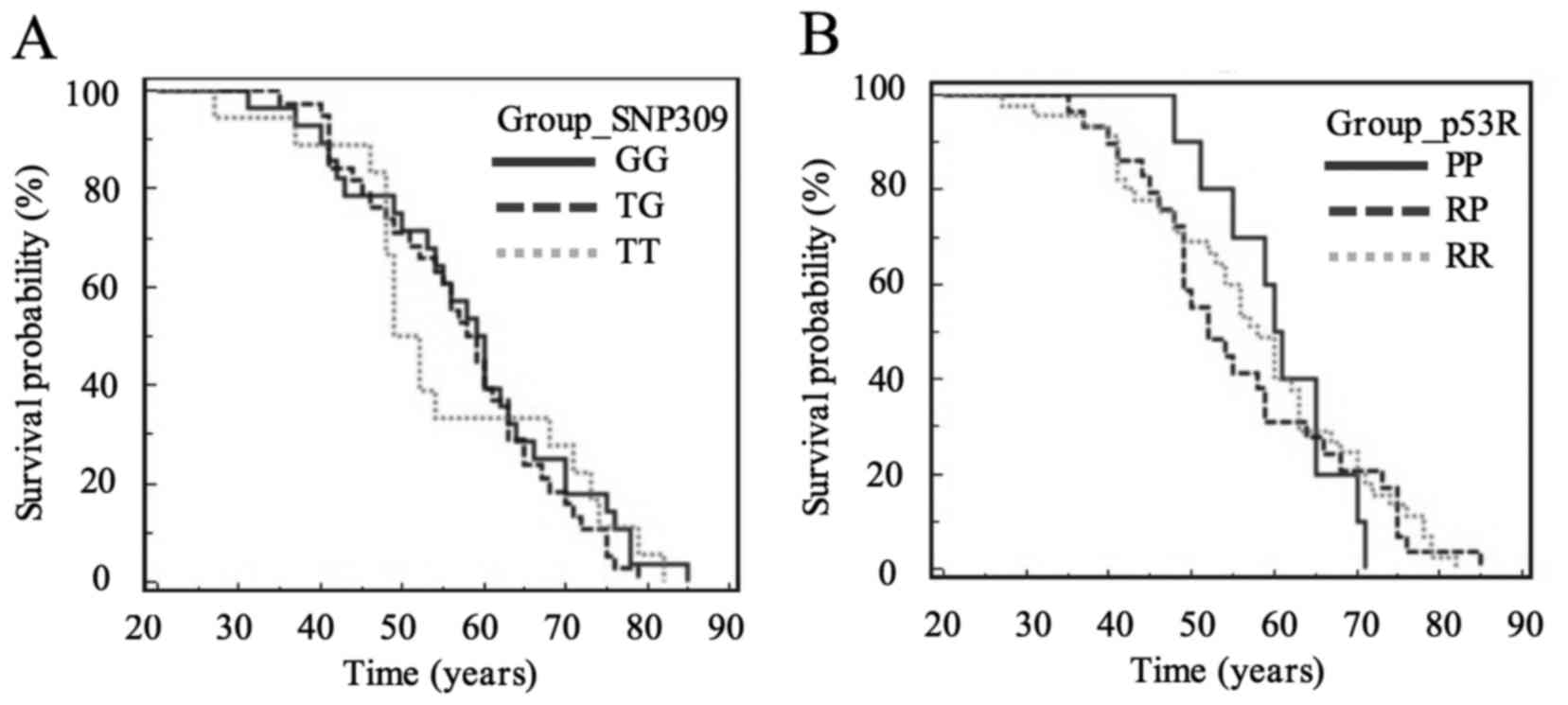|
1
|
Ploeg M, Aben KK and Kiemeney LA: The
present and future burden of urinary bladder cancer in the world.
World J Urol. 27:289–293. 2009. View Article : Google Scholar : PubMed/NCBI
|
|
2
|
Sandagdorj T, Sanjaajamts E, Tudev U,
Oyunchimeg D, Ochir C and Roder D: Cancer incidence and mortality
in Mongolia-national registry data. Asian Pac J Cancer Prev.
11:1509–1514. 2010.PubMed/NCBI
|
|
3
|
Bolortuyaa B, Bayarmaa E and Galtsog L:
Bladder cancer is diagnosed by pathology. Mongolian Med Sci.
2:12–15. 2010.
|
|
4
|
La Vecchia C and Airoldi L: Human bladder
cancer: Epidemiological, pathological and mechanistic aspects. IARC
Sci Publ. 1–157. 1999.
|
|
5
|
Burger M, Catto JW, Dalbagni G, Grossman
HB, Herr H, Karakiewicz P, Kassouf W, Kiemeney LA, La Vecchia C,
Shariat S and Lotan Y: Epidemiology and risk factors of urothelial
bladder cancer. Eur Urol. 63:234–241. 2013. View Article : Google Scholar : PubMed/NCBI
|
|
6
|
Bond GL and Levine AJ: A single nucleotide
polymorphism in the p53 pathway interacts with gender,
environmental stresses and tumor genetics to influence cancer in
humans. Oncogene. 26:1317–1323. 2007. View Article : Google Scholar : PubMed/NCBI
|
|
7
|
Hollstein M, Sidransky D, Vogelstein B and
Harris CC: p53 mutations in human cancers. Science. 253:49–53.
1991. View Article : Google Scholar : PubMed/NCBI
|
|
8
|
Hrstka R, Coates PJ and Vojtesek B:
Polymorphisms in p53 and the p53 pathway: Roles in cancer
susceptibility and response to treatment. J Cell Mol Med.
13:440–453. 2009. View Article : Google Scholar : PubMed/NCBI
|
|
9
|
Pietsch EC, Humbey O and Murphy ME:
Polymorphisms in the p53 pathway. Oncogene. 25:1602–1611. 2006.
View Article : Google Scholar : PubMed/NCBI
|
|
10
|
Thomas M, Kalita A, Labrecque S, Pim D,
Banks L and Matlashewski G: Two polymorphic variants of wild-type
p53 differ biochemically and biologically. Mol Cell Biol.
19:1092–1100. 1999. View Article : Google Scholar : PubMed/NCBI
|
|
11
|
Xu T, Xu ZC, Zou Q, Yu B and Huang XE: P53
Arg72Pro polymorphism and bladder cancer risk-meta-analysis
evidence for a link in Asians but not Caucasians. Asian Pac J
Cancer Prev. 13:2349–2354. 2012. View Article : Google Scholar : PubMed/NCBI
|
|
12
|
Yang Z, Nie S, Zhu H, Wu X, Jia S, Luo Y
and Tang W: Association of p53 Arg72Pro polymorphism with bladder
cancer: A meta-analysis. Gene. 512:408–413. 2013. View Article : Google Scholar : PubMed/NCBI
|
|
13
|
Bond GL, Hu W, Bond EE, Robins H, Lutzker
SG, Arva NC, Bargonetti J, Bartel F, Taubert H, Wuerl P, et al: A
single nucleotide polymorphism in the MDM2 promoter attenuates the
p53 tumor suppressor pathway and accelerates tumor formation in
humans. Cell. 119:591–602. 2004. View Article : Google Scholar : PubMed/NCBI
|
|
14
|
Freedman DA and Levine AJ: Regulation of
the p53 protein by the MDM2 oncoprotein-thirty-eighth G.H.A. Clowes
Memorial Award Lecture. Cancer Res. 59:1–7. 1999.PubMed/NCBI
|
|
15
|
Knappskog S and Lønning PE: Effects of the
MDM2 promoter SNP285 and SNP309 on Sp1 transcription factor binding
and cancer risk. Transcription. 2:207–210. 2011. View Article : Google Scholar : PubMed/NCBI
|
|
16
|
Hitzenbichler F, Stoehr CG, Rogenhofer M,
Wieland WF, Ruemmele P, Hartmann A and Stoehr R: Mdm2 SNP309
G-variant is associated with invasive growth of human urinary
bladder cancer. Pathobiology. 81:53–59. 2014. View Article : Google Scholar : PubMed/NCBI
|
|
17
|
Onat OE, Tez M, Ozçelik T and Törüner GA:
MDM2 T309G polymorphism is associated with bladder cancer.
Anticancer Res. 26:3473–3475. 2006.PubMed/NCBI
|
|
18
|
Sanchez-Carbayo M, Socci ND, Kirchoff T,
Erill N, Offit K, Bochner BH and Cordon-Cardo C: A polymorphism in
HDM2 (SNP309) associates with early onset in superficial tumors,
TP53 mutations, and poor outcome in invasive bladder cancer. Clin
Cancer Res. 13:3215–3220. 2007. View Article : Google Scholar : PubMed/NCBI
|
|
19
|
Horikawa Y, Nadaoka J, Saito M, Kumazawa
T, Inoue T, Yuasa T, Tsuchiya N, Nishiyama H, Ogawa O and Habuchi
T: Clinical implications of the MDM2 SNP309 and p53 Arg72Pro
polymorphisms in transitional cell carcinoma of the bladder. Oncol
Rep. 20:49–55. 2008.PubMed/NCBI
|
|
20
|
Leu JD, Wang CY, Tsai HY, Lin IF, Chen RC
and Lee YJ: Involvement of p53 R72P polymorphism in the association
of MDM2-SNP309 with breast cancer. Oncol Rep. 25:1755–1763.
2011.PubMed/NCBI
|
|
21
|
Janković S and Radosavljević V: Risk
factors for bladder cancer. Tumori. 93:4–12. 2007.PubMed/NCBI
|
|
22
|
Srivastava P, Jaiswal PK, Singh V and
Mittal RD: Role of p53 gene polymorphism and bladder cancer
predisposition in northern India. Cancer Biomark. 8:21–28.
2010–2011. View Article : Google Scholar
|
|
23
|
Hosen MB, Salam MA, Islam MF, Hossain A,
Hawlader MZ and Kabir Y: Association of TP53 gene polymorphisms
with susceptibility of bladder cancer in Bangladeshi population.
Tumour Biol. 36:6369–6374. 2015. View Article : Google Scholar : PubMed/NCBI
|
|
24
|
Li DB, Wei X, Jiang LH, Wang Y and Xu F:
Meta-analysis of epidemiological studies of association of P53
codon 72 polymorphism with bladder cancer. Genet Mol Res.
9:1599–1605. 2010. View Article : Google Scholar : PubMed/NCBI
|
|
25
|
Fajkovic H, Halpern JA, Cha EK, Bahadori
A, Chromecki TF, Karakiewicz PI, Breinl E, Merseburger AS and
Shariat SF: Impact of gender on bladder cancer incidence, staging,
and prognosis. World J Urol. 29:457–463. 2011. View Article : Google Scholar : PubMed/NCBI
|










